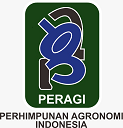Evaluasi Kestabilan Xanthomonas oryzae phages Hasil Isolasi dari Lahan Sawah Kelurahan Pulutan Kecamatan Sidorejo Salatiga pada Berbagai Kondisi pH
Abstract
Xanthomonas oryzae (Xo) merupakan patogen penyakit hawar daun bakteri (HDB) yang dapat mengurangi produktivitas padi secara nyata. Petani menanggulangi Xo dengan bakterisida sintetik dan penanaman padi varietas tahan di lapangan, namun belum sepenuhnya berhasil. Berdasarkan latar belakang tersebut perlu adanya solusi untuk mengendalikan Xo dengan mencari musuh alami yaitu virus yang menginfeksi bakteri.Tujuan penelitian ini adalah mendapatkan partikel Xanthomonas oryzae phages dan menguji stabilitas Xo phages terhadap pH. Metode untuk mendapatkan Xo phages dimulai dengan pengambilan sampel tanah, isolasi, purifikasi, dan propagasi. Pengujian stabilitas pH bertujuan untuk mengetahui seberapa banyak titer Xo phages dalam merespon suatu cekaman asam dan basa. Perlakuan pH 3 pada sampel P1, P2, dan P3 ketahanan Xo phages rendah ditunjukkan 8.1013 PFU/mL; 10.1013 PFU/mL; dan 4.1013 PFU/mL. Perlakuan pH 7 sampel P1 dan P2 ketahanan Xo phages stabil ditunjukkan 78.1013 PFU/mL dan 26.1013, sedangkan P3 Xo phages stabil pada pH 9 ditunjukkan 38.1013 PFU/mL. Perlakuan pH 11 sampel P1, P2, dan P3 turun bertahap ditunjukkan 58.1013 PFU/mL; 12.1013 PFU/mL; dan 36.1013 PFU/mL. Lysate P1 dan lysate P3 cukup tahan terhadap pH basa, dibandingkan dengan sampel lysate P2. Pemberian amelioran dan pupuk yang mengandung unsur magnesium di lahan padi akan bersifat basa, sehingga lysate P1 dan P3 diduga memiliki potensi sebagai biokontrol yang sinergis pada kondisi diatas pH 7.
Keywords
Full Text:
PDFReferences
Adams, M. H. (1959). Bacteriofag. Interscience Publishers, Inc.
Banjarnahor, B. J., Sarifuddin., & Lubis, K. S. (2019). Pengaruh Pemberian Beberapa Amelioran Terhadap Sifat Kimia Tanah Gambut Dataran Tinggi Toba dan Pengaruhnya Terhadap Pertumbuhan dan Produksi Tanaman Padi (Oryza Sativa L.). 6(1), 146–152. https://doi.org/10.51747/agrotechbiz.v6i1.443
Bayat, F., Didar, T. F., & Hosseinidoust, Z. (2021). Emerging investigator series: bacteriophages as nano engineering tools for quality monitoring and pathogen detection in water and wastewater. Environmental Science: Nano, 8(2), 367–389. https://doi.org/10.1039/d0en00962h
Chae, J. C., Hung, N. B., Yu, S. M., Lee, H. K., & Lee, Y. H. (2014). Diversity of bacteriophages infecting Xanthomonas oryzae pv. oryzae in paddy fields and its potential to control bacterial leaf blight of rice. Journal of Microbiology and Biotechnology, 24(6), 740–747. https://doi.org/10.4014/jmb.1402.02013
Czajkowski, R., Ozymko, Z., & Lojkowska, E. (2014). Isolation and characterization of novel soilborne lytic bacteriophages infecting Dickeya spp. biovar 3 ('D. solani’). Plant Pathology, 63(4), 758–772. https://doi.org/10.1111/ppa.12157
Fachrul, M. F. (2007). Metode Sampling Bioekologi. Bumi Aksara.
Gallet, R., Kannoly, S., & W. I. (2011). Effects of bacteriophage traits on plaque formation. BMC Microbiology, 11(181), 1–16. https://doi.org/10.1186/1471-2180-11-181
Guttman, B. S., & Kutter, E. M. (2002). Bacteriophage Genetics. Modern Microbial Genetics (Second Edi). https://doi.org/10.1002/047122197X.ch4
Haq, I. U., Chaudhry, W. N., Akhtar, M. N., Andleeb, S., & Qadri, I. (2012). Bacteriophages and their implications on future biotechnology: A review. Virology Journal, 9, 1–8. https://doi.org/10.1186/1743-422X-9-9
Hardanti, S., Wardani, A. K., & R. W. D. (2018). Isolasi dan karakterisasi bakteriofag spesifik Salmonella typhi dari kulit ayam. Journal of Infection in Developing Countries, 19(2), 107–116. https://doi.org/10.21776/ub.jtp.2018.019.02.5
Hardjowigeno, S. (2002). Ilmu Tanah. Mediyatama Sarana Perkasa. Jakarta.
Hatfull, G. (2020). Procedure for the isolation and purification of a phage. Phagehunting program. https://phagesdb.org
Ishaq, M., Rumiati, A. T., & Permatasari, E. O. (2017). Analisis Faktor-Faktor yang Mempengaruhi Produksi Padi di Provinsi Jawa Timur Menggunakan Regresi Semiparametrik Spline. Jurnal Sains dan Seni ITS, 6(1), 420–425. https://doi.org/10.12962/j23373520.v6i1.22451
Ji, Z., Wang, C., & Zhao, K. (2018). Rice routes of countering Xanthomonas oryzae. International Journal of Molecular Sciences, 19(10), 1–14. https://doi.org/10.3390/ijms19103008
Jurczak-Kurek, A., Gasior, T., Nejman-Faleńczyk, B., Bloch, S., Dydecka, A., Topka, G., Necel, A., Jakubowska-Deredas, M., Narajczyk, M., Richert, M., Mieszkowska, A., Wróbel, B., Wȩgrzyn, G., & Wȩgrzyn, A. (2016). Biodiversity of bacteriophages: Morphological and biological properties of a large group of phages isolated from urban sewage. Scientific Reports, 6, 1–17. https://doi.org/10.1038/srep34338
Kharisma, S. D., Cholil, A., & Aini, L. Q. (2013). Ketahanan Beberapa Genotipe Padi Hibrida (Oryza Sativa L.) Terhadap Pyricularia oryzae Cav. Penyebab Penyakit Blas Daun Padi. Jurnal HPT, 1(2), 19–27.
Lee, C. N., Hu, R. M., Chow, T. Y., Lin, J. W., Chen, H. Y., Tseng, Y. H., & Weng, S. F. (2007). Comparison of genomes of three Xanthomonas oryzae bacteriophages. BMC Genomics, 8, 1–11. https://doi.org/10.1186/1471-2164-8-442
Madigan, M. T., John, M. M., Bender, K. S., Buckley, D. H., & Stahl, D. A. (2012). BrockBiology of Microorganism. 13th ed. Pearson.
Nugraha, D. B. A. R., Aeny, T. N., & Maryono, T. (2014). Pengaruh aplikasi bakterisida berbahan aktif asam kloro bromo isosianurik 50% terhadap intensitas penyakit hawar daun bakteri dan produksi pada tanaman padi. Jurnal Agrotek Tropika, 2(1), 139–143. https://doi.org/10.23960/jat.v2i1.1945
Oliveira, A., Sillankorva, S., Quinta R., Henriques, A., Serono, R., Azeredo, J. (2009). Isolation dan characterization of bacteriophages for avian pathogen Escherichia coli strains. J. Appl Microbiol, 106, 1919–1927. https://doi.org/10.1111/j.1365-2672.2009.04145.x
Orlova, E. V. (2012). Bacteriophages and their Structural Organisation acteriophages and their Structural Organisation. https://doi.org/10.5772/34642
Ranjani, P., Gowthami, Y., Gnanamanickam, S. S., & Palani, P. (2018). Bacteriophages: A new weapon for the control of bacterial blight disease in rice caused by Xanthomonas oryzae. Microbiology and Biotechnology Letters, 46(4), 346–359. https://doi.org/10.4014/mbl.1807.07009
Sari, R. K. (2014). Analisis impor beras di Indonesia. Economics Development Analysis Journal, 3(2), 320–325.
Serdani, A. D., Aini, L. Q., & Abadi, A. L. (2018). Isolasi dan identifikasi bakteri endofit dari tanaman padi (Oryza sativa) sebagai pengendali penyakit hawar daun bakteri akibat Xanthomonas oryzae pv. oryzae. Jurnal Viabel Pertanian, 12(1), 18–26. https://doi.org/10.35457/viabel.v12i1.422
Shen, Y., & Ronald, P. (2002). Molecular determinants of disease and resistance in interaction of Xanthomonas oryzae pv. oryzae and rice. Journal Microbe and Infection, 4(1), 1361–1367. https://doi.org/10.1016/s1286-4579(02)00004-7
Sudir, S., & S. B. (2011). Reaksi padi hibrida terhadap penyakit hawar daun bakteri dan hubungannya dengan hasil gabah. Jurnal Penelitian Pertanian Tanaman, 30(2), 88-(2), 88–94.
Swings, J., Mooter, V. D., Vauterin, L., Hoste, B., Gillis, M., Mew, T. W., & Kerters, K. (1990). Reclassification of the causal agents of bacterial blight (Xanthomonas campestris pv. oryzae) and bacterial leaf streak (Xanthomonas campestris pv. oryzicola) of rice as pathovars of Xanthomonas oryzae (ex Ishiyama 1922) sp. nov., nom. rev. International Journal of Systematic Bacteriology, 40(3), 301–311. https://doi.org/10.1099/00207713-40-3-309
Refbacks
- There are currently no refbacks.



























